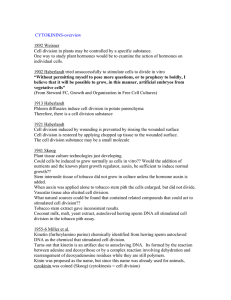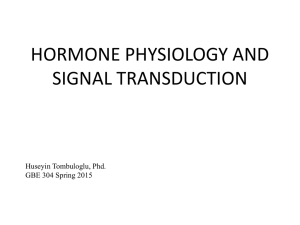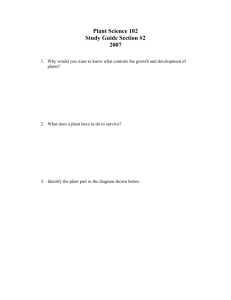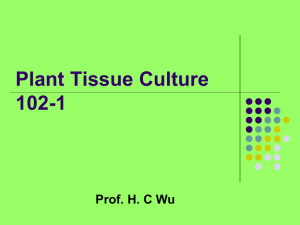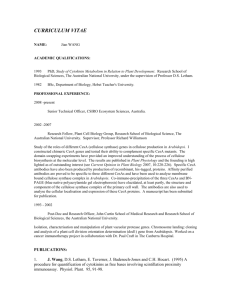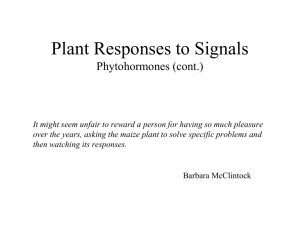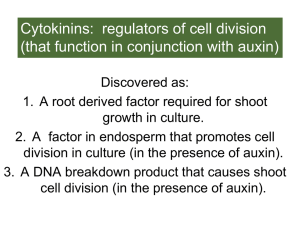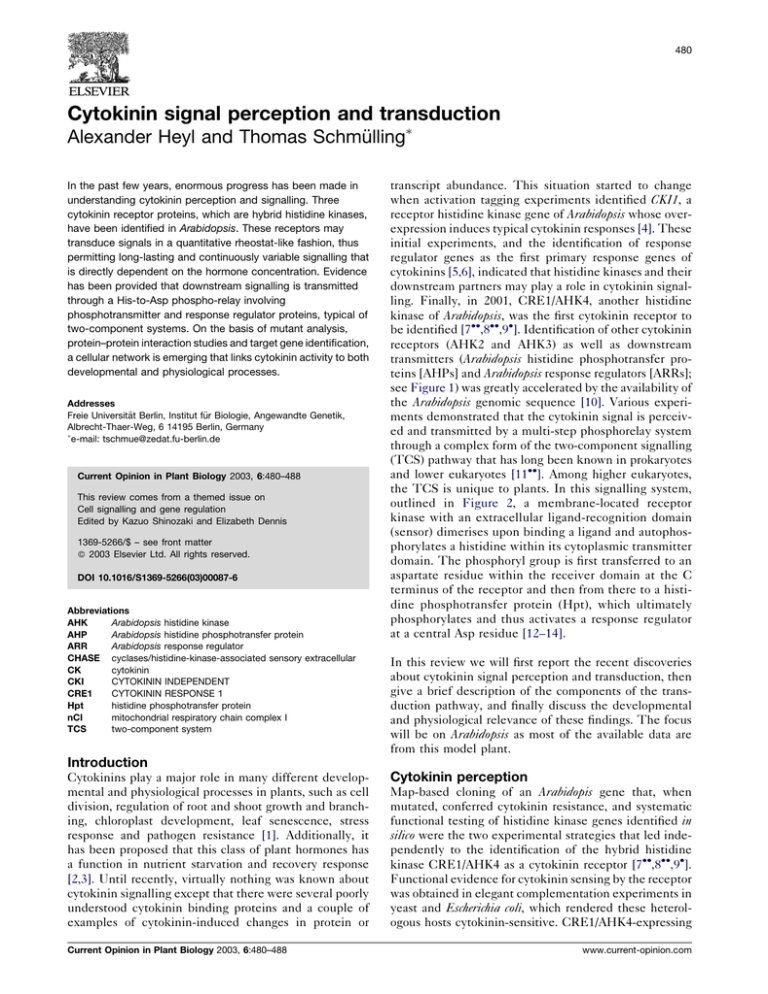
480
Cytokinin signal perception and transduction
Alexander Heyl and Thomas Schmülling
In the past few years, enormous progress has been made in
understanding cytokinin perception and signalling. Three
cytokinin receptor proteins, which are hybrid histidine kinases,
have been identified in Arabidopsis. These receptors may
transduce signals in a quantitative rheostat-like fashion, thus
permitting long-lasting and continuously variable signalling that
is directly dependent on the hormone concentration. Evidence
has been provided that downstream signalling is transmitted
through a His-to-Asp phospho-relay involving
phosphotransmitter and response regulator proteins, typical of
two-component systems. On the basis of mutant analysis,
protein–protein interaction studies and target gene identification,
a cellular network is emerging that links cytokinin activity to both
developmental and physiological processes.
Addresses
Freie Universität Berlin, Institut für Biologie, Angewandte Genetik,
Albrecht-Thaer-Weg, 6 14195 Berlin, Germany
e-mail: tschmue@zedat.fu-berlin.de
Current Opinion in Plant Biology 2003, 6:480–488
This review comes from a themed issue on
Cell signalling and gene regulation
Edited by Kazuo Shinozaki and Elizabeth Dennis
1369-5266/$ – see front matter
ß 2003 Elsevier Ltd. All rights reserved.
DOI 10.1016/S1369-5266(03)00087-6
Abbreviations
AHK
Arabidopsis histidine kinase
AHP
Arabidopsis histidine phosphotransfer protein
ARR
Arabidopsis response regulator
CHASE cyclases/histidine-kinase-associated sensory extracellular
CK
cytokinin
CKI
CYTOKININ INDEPENDENT
CRE1
CYTOKININ RESPONSE 1
Hpt
histidine phosphotransfer protein
nCI
mitochondrial respiratory chain complex I
TCS
two-component system
transcript abundance. This situation started to change
when activation tagging experiments identified CKI1, a
receptor histidine kinase gene of Arabidopsis whose overexpression induces typical cytokinin responses [4]. These
initial experiments, and the identification of response
regulator genes as the first primary response genes of
cytokinins [5,6], indicated that histidine kinases and their
downstream partners may play a role in cytokinin signalling. Finally, in 2001, CRE1/AHK4, another histidine
kinase of Arabidopsis, was the first cytokinin receptor to
be identified [7,8,9]. Identification of other cytokinin
receptors (AHK2 and AHK3) as well as downstream
transmitters (Arabidopsis histidine phosphotransfer proteins [AHPs] and Arabidopsis response regulators [ARRs];
see Figure 1) was greatly accelerated by the availability of
the Arabidopsis genomic sequence [10]. Various experiments demonstrated that the cytokinin signal is perceived and transmitted by a multi-step phosphorelay system
through a complex form of the two-component signalling
(TCS) pathway that has long been known in prokaryotes
and lower eukaryotes [11]. Among higher eukaryotes,
the TCS is unique to plants. In this signalling system,
outlined in Figure 2, a membrane-located receptor
kinase with an extracellular ligand-recognition domain
(sensor) dimerises upon binding a ligand and autophosphorylates a histidine within its cytoplasmic transmitter
domain. The phosphoryl group is first transferred to an
aspartate residue within the receiver domain at the C
terminus of the receptor and then from there to a histidine phosphotransfer protein (Hpt), which ultimately
phosphorylates and thus activates a response regulator
at a central Asp residue [12–14].
In this review we will first report the recent discoveries
about cytokinin signal perception and transduction, then
give a brief description of the components of the transduction pathway, and finally discuss the developmental
and physiological relevance of these findings. The focus
will be on Arabidopsis as most of the available data are
from this model plant.
Introduction
Cytokinins play a major role in many different developmental and physiological processes in plants, such as cell
division, regulation of root and shoot growth and branching, chloroplast development, leaf senescence, stress
response and pathogen resistance [1]. Additionally, it
has been proposed that this class of plant hormones has
a function in nutrient starvation and recovery response
[2,3]. Until recently, virtually nothing was known about
cytokinin signalling except that there were several poorly
understood cytokinin binding proteins and a couple of
examples of cytokinin-induced changes in protein or
Current Opinion in Plant Biology 2003, 6:480–488
Cytokinin perception
Map-based cloning of an Arabidopis gene that, when
mutated, conferred cytokinin resistance, and systematic
functional testing of histidine kinase genes identified in
silico were the two experimental strategies that led independently to the identification of the hybrid histidine
kinase CRE1/AHK4 as a cytokinin receptor [7,8,9].
Functional evidence for cytokinin sensing by the receptor
was obtained in elegant complementation experiments in
yeast and Escherichia coli, which rendered these heterologous hosts cytokinin-sensitive. CRE1/AHK4-expressing
www.current-opinion.com
Cytokinin signal perception and transduction Heyl and Schmülling 481
Figure 1
TM
LB
HK
TM
RLD
RD
AHK2
1173 aa
CHASE
H N G1 F G2
D D
K
AHK3
1176 aa
CHASE
H N G1 F G2
D D
K
CRE1/
AHK4
1057 aa*
CHASE
H N G1 F G2
D D
K
T278
I
G470
R
T955
I
A1009
T
XHQXKGSSXS
AHPs
127–157 aa
H
B-type ARR
382–690 aa
D D
K
RD
D D
K
RD
A-type ARR
122–259 aa
NLS
NLS
AD
OD
GARP
NLS
P/Q-rich
domain
AD
Current Opinion in Plant Biology
Structures of cytokinin receptors and other proteins of the cytokinin signalling pathway. Amino acids that participate in the phosphorelay are circled.
Other characteristic consensus motifs are also indicated. Mutations that lead to loss of function in CRE1/AHK4 are shown below the CRE1/AHK4
structure [17,20]. Abbreviations: aa, amino acids; AD, acidic domain; CHASE, cyclases/histidine kinases associated sensory extracellular; GARP,
DNA-binding motif; HK, histidine kinase; LB, putative ligand binding domain; NLS, nuclear localisation signal; OD, output domain; RD, receiver domain;
RLD, receiver-like domain; TM, transmembrane domain. Domains are according to [12,27,34,38]. A longer open reading frame of CRE1 coding for
additional 23 amino acids at the N-terminal end was also identified [7].
E. coli responded to cytokinins of the isopentenyl and
zeatin types, as well as to a diphenylurea derivative with
cytokinin activity, thidiazuron, at concentrations as low as
5 108 M [8,15]. Biochemical analyses revealed a
dissociation constant (Kd) for isopentenyl adenine of
4:5 109 M, indicating a high affinity of AHK4 for
the biologically active free base of the hormone [15].
Two other histidine kinases, AHK2 and AHK3, have
been shown to be active in the same complementation
test system and to render protoplasts cytokinin-sensitive
[11,15]. Expression of the above-mentioned earlier
receptor candidate CKI1 in Arabidopsis protoplasts or
heterologous hosts led to constitutive phenotypes that
were independent of cytokinin dose [11,15]. In planta,
CKI1 is essential for megagametogenesis as loss-of-function mutants display a female gametophytic lethal phenotype [16]. Together, it is not entirely clear whether
CKI1 functions as a cytokinin receptor or whether its
overexpression triggers cytokinin-dependent activities
that are not normally under the control of CKI1.
The three cytokinin receptor genes differ in their expression pattern. CRE1/AHK4 is mainly expressed in the
roots, whereas AHK2 and AHK3 are present in all major
organs [7,17,18]. It is interesting to note that in a
global expression analysis during in vitro shoot development from root calli the expression of CRE1/AHK4 was
transiently upregulated at a time that corresponded to the
acquisition of competence for shoot formation, whereas
the expression level of AHK3 did not change [19]. It was
www.current-opinion.com
also shown that cytokinin enhances CRE1/AHK4 expression, indicating the existence of a positive-feedback loop
in cytokinin signalling [20].
The primary structure of all three cytokinin receptors
displays two to three transmembrane domains at the
N-terminal part, followed by a transmitter (histidine
kinase) domain and two receiver domains (Figure 1).
The predicted extracellular ligand-binding regions, which
are 270 amino acids long, have drawn special attention,
as they are the putative recognition sites for cytokinins. In
CRE1/AHK4 mutation of Thr278 to Ile in this domain
leads to a loss of function [17]. Sequence comparison has
shown the presence of this domain in other receptor-like
proteins in both prokaryotes and lower eukaryotes [21,22].
Although conservation at the amino acid level is relatively
low, the secondary structure is highly homologous, with a
characteristic pattern of a-helices and b-sheets. Because of
its presence in a variety of functionally diverse membrane
receptor proteins that recognise cytokinin-like adenine
derivatives or peptide ligands and that have intracellular
histidine kinase or nucleotide cyclase domains, the
domain has been named the CHASE domain (cyclases/
histidine-kinase-associated sensory extracellular). As the
CHASE domain is absent from all sequenced archaeal
genomes, it has been suggested that this domain might
have been acquired through a lateral transfer from bacteria
to plants via the chloroplast, which is of cyanobacterial
origin [21,22]. In Arabidopsis, the CHASE domain is
specific for AHK2, AHK3 and CRE1/AHK4.
Current Opinion in Plant Biology 2003, 6:480–488
482 Cell signalling and gene regulation
Figure 2
CRE1/AHK4
(or AHK2/AHK3)
AHPs
P
H
HH
H
P
P
D D
P
H
H
P
Cytoplasm
Nucleus
H
B-type ARRs
H
D
P
D
P
Other
B-type ARR
regulated
responses
Transcription
of A-type
ARR genes
A-type ARRs
D
D
P
Modulation of responses
to cytokinin, auxin, light,
stress, nutritional status
Current Opinion in Plant Biology
A model for cytokinin signal transduction via a His-to-Asp phosphorelay. The structure of CRE1/AHK4 is shown as an example. Ligand binding induces
receptor dimerisation and autophosphorylation. Transfer of the phosphoryl group by activated receptors activates AHPs which transport the signal
from the cytoplasm to type-B ARRs in the nucleus. Type-B response regulators transcribe target genes, among them type-A ARR genes. Type-A
response regulators may downregulate the primary cytokinin signal response via a negative feedback loop, modulate downstream activities of
cytokinins in a positive or negative fashion or modulate other signalling pathways through protein–protein interaction. A more complex regulation than
shown in the model may exist. Abbreviations: D, aspartate residue, H, histidine residue, P, phosphoryl group.
The conserved His residue in the cytoplasmic transmitter
domain has been shown to be functionally essential [7].
Of the two receiver domains the first is referred to as
receiver-like and is not believed to be functional, as the
phospho-accepting aspartate residue is only present in
AHK2 [12,15,18]. The C-terminal receiver domain of
AHKs is thought to transmit the signal to the histidine
phospho-transmitter proteins (AHPs). Indeed, deletion of
the entire receiver domain or mutation of the conserved
Current Opinion in Plant Biology 2003, 6:480–488
Asp973 destroys the ability of CRE1/AHK4 to complement heterologous signalling mutants [7,8,11].
Furthermore, co-expressing AHK4 together with AHP2
or AHP5 in the mutant host resulted in a failure to
complement, probably due to signal titration [8].
The mechanism by which signalling of the cytokinin
receptors is reset is not known. Resetting is usually
achieved through the intrinsic instability of the phosphoryl
www.current-opinion.com
Cytokinin signal perception and transduction Heyl and Schmülling 483
group and/or via regulatory phosphatase activity of the
receptor itself or of additional proteins [23]. For other
histidine kinase receptors it has been shown that the
external signal can control the ratio of kinase activity to
phosphatase activity of the receptor, permitting them to
function as an on–off switch or as a rheostat, depending on
the concentration differences of the ligand [23]. Cytokinin
receptors that function according to the rheostat model
could make the signal strength directly dependent upon
the cytokinin concentration over a broad concentration
range. Furthermore, the model could explain continuous
signalling over a longer period without gross changes in
ligand concentration. This might be important for the
mediation and maintenance of slow and complex cytokinin
responses such as shoot formation. Whether cytokinin
receptors function as rheostats remains to be shown.
Cytokinin signalling
Current knowledge suggests that the downstream signalling components of the cytokinin signal-transduction
pathway consist in Arabidopsis of five histidine phospho-transmitters (AHPs; [24]) and 22 response regulators
(ARRs; [12,25–28]). It should be noted that only few of
these elements have been functionally characterised and
that clear evidence of a link to cytokinin signalling is
missing in most cases.
AHPs
The five AHP genes code for proteins of 12 kDa, all of
which contain the highly conserved XHQXKGSSXS
motif responsible for the His-Asp phospho-transfer
([12]; Figure 1). AHPs transmit the signal from the
receptor, which is presumably localised in the plasma
membrane, to ARRs, which are mostly found in the
nucleus [11,29]. Importantly, it has been shown that
upon induction by cytokinin some AHPs (AHP1 and
AHP2) localise specifically and transiently to the nucleus,
indicating that members of this class of protein function
as cytoplasmic-nuclear shuttles [11]. Additional evidence for the function of AHPs in the phosphorelay
comes from several experiments. It has been demonstrated that AHP1, AHP2 and AHP3 functionally complement a yeast Hpt mutant, and interactions between
different AHPs and AHKs or ARRs have been detected
using yeast, E. coli and in vitro assays ([11,24,25,30–
32,33]; see Table 1).
ARRs
The final output element in the TCS in plants is the
response regulator, whose activity is altered by its phosphorylation state. Analysis of the Arabidopsis genome
sequence reveals the existence of 22 predicted response
regulator (ARR) genes, characterised by the presence of
the hallmark residues DDK, necessary for phosphoaccepting activity ([28]; Figure 1). The ARRs are divided
into two major classes, the A- and the B-type, on the basis
of their structure. The 11 type-A ARRs consist mainly of
www.current-opinion.com
the receiver domain with a short extension at the N- and
C-terminal ends. By contrast, the 11 type-B ARRs contain
a C-terminal output domain in addition to the receiver
domain. The genes coding for the two types of ARR
respond differently to cytokinin. A-type ARR genes are
rapidly induced in the presence of cytokinin and fulfil the
criteria of a primary response gene [34]. The expression
level of B-type ARR genes is not influenced by cytokinin
[25,35,36]. Type-B ARRs act upstream of type-A ARRs
and are discussed first.
B-type ARRs
The C-terminal output domain of type-B ARRs contains
the 60-amino-acid GARP motif (so-called after the
founding members Golden2, ARR and Psr1; it is also
termed B motif or ARRM) (Figure 1), which is distantly
related to the Myb repeat of transcription factors
[33,37,38]. The predicted secondary structure of this
domain, as determined by NMR spectroscopy, contains
three a-helices and recognises the major groove of DNA
with residues located in a helix-turn-helix variant motif in
essentially the same way as homeobox proteins. Structural analysis suggested that type-B ARRs might bind
DNA as a monomer [39]. The DNA motif optimal for
binding is 50 -(A/G)GAT(T/C)-30 with the GAT motif in
the middle being of special importance [33,38,39]. 50 AGATT-30 was found to be optimal for ARR1, ARR2 and
ARR10 [38,39], whereas ARR11 bound preferentially to
50 -GGATT-30 [40]. Because these recognition motifs
occur frequently, it was suggested that additional factors
are needed to increase the specificity of DNA recognition
in planta [38]. In addition to the GARP domain, and
consistent with a function as transcription factors, the
C-terminal parts contain nuclear localisation sequences
and P/Q-rich, acidic domains. The latter domain has been
demonstrated to be sufficient for transactivation in the
case of ARR1, ARR2 and ARR11 [36,38,40]. As predicted
by the presence of the nuclear localisation sequences,
B-type ARRs are found in the nucleus [11,12,33,38].
Two reports showed that ARR1, ARR2 and ARR10 are
able to activate the transcription of several A-type ARRs
directly, independently of exogenous cytokinin, although
activation is further enhanced by additional cytokinin
[11,41]. Furthermore, overexpression of ARR1,
ARR2 or the C-terminal parts of ARR1 or ARR11 (the
regulatory N-terminal part was removed) mimics some
cytokinin effects in transgenic plants (disordered cell division and ectopic shoot formation) and renders plants more
sensitive to cytokinin. Collectively, these data suggest that
B-type ARRs could play a central, rate-limiting role in
cytokinin signalling [11,40,41]. Evidence further indicated that the N-terminal receiver has a suppressor function in the absence of cytokinin [11,41]. Interestingly,
overexpression of the C-terminal part of ARR1 (ARR1-C)
upregulated several type-A ARR genes whereas ARR11-C
overexpression did not. However, the developmental
Current Opinion in Plant Biology 2003, 6:480–488
484 Cell signalling and gene regulation
Table 1
Features of cytokinin receptors and components of the signalling pathway.
Gene name
MIPS designation
Features
Arabidopsis cytokinin receptors
AHK2
At5g35750
Increases CK dependent ARR6 promoter activity [11]; expression in roots, leaves, stem, flowers [58].
AHK3
At1g27320
Increases CK dependent ARR6 promoter activity [11]; expression in roots, leaves, stem, flowers [18].
CRE1/AHK4
At2g01830
Loss of function mutants are CK resistant [7,20]; increases CK dependent ARR6 promoter activity [11];
localised in the plasma membrane in yeast [8,15]; interacts with AHP2/AHP5>AHP3 >AHP18;
downregulated by Pi starvation, upregulated by CK [20]; upregulated during shoot induction [19];
expressed predominantly in root vascular tissue [7,17,18].
Arabidopsis histidine phosphotransfer protein gene family (AHP)
AHP1
AT3g21510
Interacts with ARR1 [24], ARR2 [33], ARR4, ARR9 [58] and ARR10 [25]; translocates from cytoplasm
to nucleus upon CK treatment [11], expression in roots [30] and seedlings [31].
AHP2
AT3g29350
Interacts with ARR1, TCP10 [24], ARR2 [33], ARR10 [25], CKI1 and AHK1 [32]; translocates from cytoplasm
to nucleus upon CK treatment [11]; expression in roots, leaves, stems, siliques [30] seedlings [31].
AHP3
AT5g39340
Interacts with ARR1, ARR10 [25], CKI1, ARR9 [32], TCP10 [24]; expression in roots, leaves, stems, siliques [30]
and seedlings [31].
AHP4
AT3g16360
Weak expression in roots and leaves [29].
AHP5
At1g03430
No translocation from cytoplasm to nucleus upon CK treatment [11]; expression in roots and leaves [29].
Arabidopsis type B response regulator genes (type B ARR)
ARR1
At3g16857
Activates transcription of CK response genes [11,38]; interacts with AHP2 [24]; nuclear localisation [38]; ESTs
from leaves [1]; overexpression causes aberrant cell proliferation [41].
ARR2
At4g16110
Activates transcription of CK response genes; overexpression promotes cell proliferation and shoot growth
[11,33,38]; interacts with AHP1 and AHP2 [24,33]; nuclear localisation [11,38]; expression in pollen [33].
ARR10
At4g31920
Activates transcription of ARR6 [11]; nuclear localisation [39]; interacts with AHP1, AHP2, AHP3 [25];
expression in root, leaves, flowers and siliques [25].
ARR11
At1g67710
Binds DNA specifically [40] and activates transcription [36]; interacts with AHP2 [40]; expressed in roots;
overexpression causes aberrant cell proliferation [40].
ARR12
At2g25180
ESTs from developing seeds and roots
ARR13
At2g27070
No EST
ARR14
At2g01760
ESTs from leaves
ARR18
At5g58080
EST from developing seeds
ARR19
At1g49190
No EST
ARR20
At3g62670
No EST
ARR21
At5g07210
No EST
Arabidopsis type A response regulator genes (type A ARR)
ARR3
At1g59940
ESTs from leaves
ARR4
At1g10470
Represses CK induced transcription of ARR6 [11]; renders tissues more CK sensitive [48]; interacts with
PhyB [44], AHP1 [32], AtDBP1 and AtDBP2 [52]; expressed in leaves, stem, flowers, roots and induced
by osmotic stress and CK [5,34,44,45,46].
ARR5
At3g48100
Represses CK induced transcription of ARR6 [11]; expressed in shoot and root meristems; induced in leaves,
flowers, stem, roots, siliques by CK, osmotic stress and during shoot induction [5,19,34,45,46].
ARR6
At5g62920
Represses CK induced transcription of ARR6 [11]; nuclear localisation [11]; expression induced by
CK [34,11,45].
ARR7
At1g19050
Represses CK induced transcription of ARR6 [11]; nuclear localisation [43]; expression induced by CK
[34,45].
ARR8
At2g41310
Renders transgenic overexpressors CK insensitive [48]; expression in roots induced by CK and osmotic stress
[35,46].
ARR9
At3g57040
Interacts with AHP1 and AHP3 [32]; expression in flower, seeds, leaves, roots [46], induced by CK [35].
ARR15
At1g74890
Nuclear localisation [45]; expression in stele of root tips [45] and induced by CK [34].
ARR16
At2g40670
Cytoplasmic localisation [45]; expression in endodermis of root tips [45]; induced by CK [34].
ARR17
At3g56380
No EST
ARR22
At3g04280
EST from etiolated seedlings
EST, expressed sequence tag.
consequences of overexpression were similar in both
cases, suggesting at least partially different signalling
pathways for these two type-B ARRs [40,41]. An arr1
loss-of-function mutant had longer roots than the wild
type and was partially resistant to cytokinin, characteristics shared by cytokinin-deficient plants [41,42].
However, arr1 mutant plants did not show other gross
Current Opinion in Plant Biology 2003, 6:480–488
phenotypic alterations, suggesting redundancy among
type-B ARRs [41].
A-type ARRs
In addition to the receiver domain, six of the eleven
A-type ARR proteins (ARR3, ARR4, ARR7, ARR8,
ARR9, ARR15) contain a short acidic C-terminal extension
www.current-opinion.com
Cytokinin signal perception and transduction Heyl and Schmülling 485
[34] (Figure 1). The extension was shown to be
responsible for nuclear localisation in the case of ARR7
[43]. The subcellular localisation of different A-type ARR
is cytosolic, nuclear, or both, depending on the gene and
on conditions [11,43,44,45].
The expression of A-type ARRs was highest in roots, but
transcripts were detected in all adult organs of plants with
variations between the different genes [34,46]. Transcript abundance of most if not all A-type ARRs increases
rapidly (within 10 min) in response to cytokinin [34]. A
strong response was obtained for ARR4, ARR5, ARR6, and
ARR7. ARR8, ARR9, ARR15 and ARR16 showed a weak
and somewhat delayed response. Transcripts for ARR3 and
ARR17 were not identified on RNA blots [34,35,45].
Nuclear run-on transcription analysis showed that the
increase of transcript abundance is at least partially regulated on the transcriptional level [34]. Plants carrying an
ARR5::GUS fusion gene showed expression mainly in the
shoot and root apical meristems, which are sites where
cytokinins exert regulatory functions [34,42] Upon
induction by cytokinin, GUS enzyme activity accumulated in most cells of transgenic seedlings, indicating that
almost all cells are competent to respond to cytokinins
[34,47]. By contrast, the cytokinin-responsiveness of
ARR15::GUS and ARR16::GUS transgenes was limited
in seedling roots to the stele containing the vasculature
and the endodermis close to the root tip, respectively
[45]. This indicates that the cytokinin responsiveness of
ARR5, ARR15 and ARR16 in the root is mediated by at
least partially different components of the cytokinin
signalling pathway. The simplest explanation is that each
gene requires a specific combination of signalling elements for activation that is present only in the responsive
cells. In the same vein, transcript accumulation of ARR15
and ARR16 in response to cytokinin was absent in the roots
of cre1 mutants, whereas the accumulation of all other
type-A ARR gene transcripts was not inhibited [45]. This
indicates redundant cytokinin receptor functions in the
root but also the existence of specific pathways.
The expression characteristic of type-A ARR genes suggests that they are likely to be mediators of cytokinin
responses within the cell, but little is known about their
molecular functions. Transient overexpression of ARR4,
ARR5, ARR6 and ARR7 in protoplasts resulted in the
repression of a ARR6::LUC reporter gene, indicating
negative-feedback control of the cytokinin signalling
pathway [11]. This conclusion is supported by diminished cytokinin responses in stable transgenic ARR8 overexpressers. However, in contrast to the general idea of a
negative feedback function of type-A ARRs, stable overexpression of ARR4 in transgenic plants enhanced cytokinin responsiveness [48]. Together, these data indicate
that type-A ARRs can be positive or negative regulators,
depending on the gene and the output reaction analysed
[11,48] This hypothesis is consistent with specific
www.current-opinion.com
combinations of the signalling components mediating
different responses.
Developmental and physiological
significance
Few data are available to place the cytokinin signalling
components in a functional context. Results have been
mainly obtained with CRE1/AHK4, for which extensive
analyses of loss-of-function mutants indicate roles in
embryonic cell proliferation, shoot regeneration in vitro
and regulation of the phosphate starvation response
[7,17,20]. Additional information about functional
links of the cytokinin signalling pathway was obtained
from the identification of target genes and from protein–
protein interaction studies.
CRE1/AHK4 is expressed in the four innermost cells of
the globular embryo, which are the precursors to the
vascular tissue, and remains associated with the root
vasculature throughout embryogenesis and in the primary
root [17]. Consistent with the expression pattern, in the
wooden leg mutant, which proved to be allelic to CRE1/
AHK4, the number of vascular initials is reduced and
these subsequently form xylem but not phloem cells
[17]. This finding establishes an important role for
cytokinins in embryonic developmental patterns and,
more specifically, in vascular morphogenesis [17,49].
Moreover, cytokinin resistance of cre1 mutants in a root
elongation test indicates a role for CRE1 and the TCS in
mediating cytokinin signals to the root meristem, whose
activity is controlled by cytokinin [7,42].
Two hybrid screens revealed an interaction between
AHP1, AHP2 and AHP3 and the putative transcription
factor TCP10 [24]. The TCP domain is found for example in TB1 (Teosinte Branched 1) of Zea mays, which
represses growth of lateral branches, and CYC (Cycloidea) and DICH (Dichotoma) of Antirrhinum majus, which
regulate flower symmetry [50,51]. This interaction indicates that AHPs may also transmit their signal to other
transcription factors than type-B ARRs.
Members of a class of genes that is likely to be regulated
by ARR2 code for several components of the mitochondrial respiratory chain complex I (nCI) from Arabidopsis,
which generates the proton-motive force of ATP synthesis [33]. ARR2 is strongly expressed in pollen and binds
to a cis-acting DNA sequence in the promoter of nCI
genes, which contains the so-called pollen box and is
necessary for upregulating gene expression during sporogenesis. This suggests that cytokinins may be involved
in controlling the capacity for ATP synthesis during
sporogenesis [33].
ARR4 has been shown to accumulate in response to light
and to interact with the extreme N terminus of phytochrome B [44]. This interaction results in the stabilisation
Current Opinion in Plant Biology 2003, 6:480–488
486 Cell signalling and gene regulation
of the physiologically active form of phytochrome B, and
plants overexpressing ARR4 display hypersensitivity to
red light. This interaction provides, for the first time, a
mechanistic basis for the long-known cross-talk between
cytokinin and light signal transduction pathways [27].
ARR4 also interacts with AtDBP1 and AtDBP2 [52],
DNA-binding proteins previously identified as auxinresponse genes [53]. This interaction could provide a
link between auxin and cytokinin signalling.
Low phosphate availability triggers several adaptive
changes including the induction of specific genes (Pi
genes). Cytokinin represses the expression of some Pi
genes in response to phosphate deprivation [2]. Several
mutant alleles of CRE1/AHK4 were identified in a screen
for mutants that showed a reduced repression of Pi genes in
the presence of cytokinin. This indicates that the hormone
has a role in Pi starvation signalling [20]. Consistent with
this finding, it was shown that the expression level of
CRE1/AHK4 decreased during Pi starvation [20].
It has been proposed earlier that cytokinins have a role in
coordinating root and shoot development by carrying
information about the nutritional status of the root to
the shoot. It was recently shown that nitrogen treatment
of nitrogen-starved plants leads to increased cytokinin
export from the root. The cytokinin is then transported
via the xylem to the leaves, where it causes enhanced
expression of type-A response regulator genes [3,6,54,55].
Thus cytokinin may represent a long-distance signal for
the relief of nitrogen starvation that is able to trigger
downstream events in shoot tissues. It was also proposed
that cytokinins and the TCS may be involved in mediating nitrogen-dependent root development [49].
The expression of some ARR genes of the A- and B-type
in response to abiotic stimuli such as salt, drought and low
temperature indicates cross-talk between the signalling
pathways of these abiotic stresses and cytokinin [46]. This
finding is consistent with the fact that AHK1, another
member of the Arabidopsis His-kinase family, possibly
functions as an osmosensor [56].
Transgenic plants overexpressing ARR2 could overcome
the glucose repression response, thus mimicking the
mutation in the glucose-response mutant gin2 and indicating an intimate link between cytokinin signalling and
the HXK1 glucose-signalling pathway [57].
Conclusions
The identification of the components of cytokinin perception and signal transduction has occurred at a breathtaking pace. Within a very short time, cytokinins have
gone from being powerful but enigmatic molecules to one
of the best understood plant hormones. The fact that
genes for all proteins of the TCS, including His-kinases
containing a CHASE domain, have been found in several
Current Opinion in Plant Biology 2003, 6:480–488
other plant species suggests that the pathway elucidated
in Arabidopsis may be of a general nature.
The TCS has the necessary complexity to mediate
different cytokinin responses in different tissues and
at different developmental stages. Characteristically,
multiple steps providing regulatory checkpoints and
relay stations for cross-talk are used for the fine-tuning
of the signal. Elucidation of the pathway is at a very early
stage. Detailed knowledge about the tissue specificity of
expression of individual genes, analysis of knockout
phenotypes and the identification of more interacting
proteins and target genes is needed and will be achieved
rapidly with genomic tools. Data should be obtained
from the whole plant, as non-physiological interactions
are likely to occur in heterologous hosts and transient
test systems. Certainly different biochemical characteristics of the receptors and other components will add an
additional level of complexity to cytokinin signal perception and transduction. Last but not least, although it
is tempting to think that the TCS provides all the
components for cytokinin signalling, the possibility that
alternative pathways are used should not be forgotten. In
fact, pharmacological experiments indicate that they
may exist [47].
References and recommended reading
Papers of particular interest, published within the annual period of
review, have been highlighted as:
of special interest
of outstanding interest
1.
Mok DWS, Mok MC: Cytokinin metabolism and action. Annu Rev
Plant Phys Mol Biol 2001, 52:89-118.
2.
Martin AC, del Pozo JC, Iglesias J, Rubio V, Solano R, de la Peña A,
Leyva A, Paz-Ares J: Influence of cytokinins on the expression of
phosphate starvation responsive genes in Arabidops
is. Plant J 2000, 24:559-567.
3.
Sakakibara H, Suzuki M, Takei M, Deji A, Taniguchi M, Sugiyama T:
A response-regulator homologue possibly involved in nitrogen
signal transduction mediated by cytokinin in maize.
Plant J 1998, 14:337-344.
4.
Kakimoto T: CKI 1, a histidine kinase homolog implicated in
cytokinin signal transduction. Science 1996, 274:982-985.
5.
Brandstatter I, Kieber JJ: Two genes with similarity to bacterial
response regulators are rapidly and specifically induced by
cytokinin in Arabidopsis. Plant Cell 1998, 10:1009-1019.
6.
Taniguchi M, Kiba T, Sakakibara H, Ueguchi C, Mizuno T,
Sugiyama T: Expression of Arabidopsis response regulator
homolog is induced by cytokinins and nitrate. FEBS Lett 1998,
429:259-262.
7.
Inoue T, Higuchi M, Hashimoto Y, Seki M, Kobayashi M, Kato T,
Tabata S, Shinozaki K, Kakimoto T: Identification of CRE 1 as
a cytokinin receptor from Arabidopsis. Nature 2001,
409:1060-1063.
This article describes the first isolation of a cytokinin receptor through
positional cloning of the mutated CRE1 gene. CRE1 expression conferred
a cytokinin-dependent growth phenotype on a yeast mutant.
8.
Suzuki T, Miwa K, Ishikawa K, Yamada H, Aiba H, Mizumo T: The
Arabidopsis sensor His-kinase, AHK4, can respond to
cytokinins. Plant Cell Phys 2001, 42:107-113.
This article describes the identification of CRE1/AHK4 as a cytokinin
sensor by coupling it to the two-component phosphorelay systems of
E. coli and fission yeast.
www.current-opinion.com
Cytokinin signal perception and transduction Heyl and Schmülling 487
9.
Ueguchi C, Sato S, Kato T, Tabata S: The AHK4 gene involved in
the cytokinin-signaling pathway as a direct receptor molecule
in Arabidopsis thaliana. Plant Cell Phys 2001, 42:751-755.
Arabidopsis mutant analysis and heterologous expression experiments
suggest that CRE1/AHK4 acts as a cytokinin receptor.
10. The Arabidopsis Genome Initiative: Analysis of the genome
sequence of the flowering plant Arabidopsis thaliana.
Nature 2000, 408:796-815.
11. Hwang I, Sheen J: Two-component circuitry in Arabidopsis
cytokinin signal transduction. Nature 2001, 413:383-389.
This article links the different components of the TCS to cytokinin
signaling using a transient expression system. The function of AHPs
as a cytokinin-dependent shuttle between the cytoplasm and nucleus
is described. The concept of a negative feedback loop through type-A
ARRs is developed.
12. Hwang I, Chen HC, Sheen J: Two-component signal
transduction pathways in Arabidopsis. Plant Phys 2002,
129:500-515.
13. Sheen J: Phosphorelay and transcription control in cytokinin
signal transduction. Science 2002, 296:1650-1652.
14. Hutchison CE, Kieber JJ: Cytokinin signaling in Arabidopsis.
Plant Cell 2002, 14:S47-S59.
15. Yamada H, Suzuki T, Terada K, Takei K, Ishikawa K, Miwa K,
Mizuno T: The Arabidopsis AHK4 histidine kinase is a cytokininbinding receptor that transduces cytokinin signals across the
membrane. Plant Cell Physiol 2001, 42:1017-1023.
Characterisation of CRE1/AHK4, AHK3 and AHK2 receptor activities in
E. coli, and cytokinin binding studies.
16. Pischke MS, Jones LG, Otsuga D, Fernandez DE, Drews GN,
Sussman MR: An Arabidopsis histidine kinase is essential
for megagametogenesis. Proc Natl Acad Sci USA 2002,
99:15800-15805.
This work establishes a role for CKI1 in female gametophytic development by means of loss-of-function analysis.
17. Mähönen AP, Bonke M, Kaupinnen L, Riikonen M, Benfey PN,
Helariutta Y: A novel two-component hybrid molecule regulates
vascular morphogenesis of the Arabidopsis root. Genes Dev
2000, 14:2938-2943.
This article shows that WOL (allelic to CRE1/AHK4) is expressed specifically in the vasculature from the early embryogenesis on and is required
for cell divisions before vascular differentiation.
18. Ueguchi C, Koizumi H, Suzuki T, Mizuno T: Novel family of sensor
histidine kinase genes in Arabidopsis thaliana. Plant Cell Phys
2001, 42:231-235.
19. Che P, Gingerich DJ, Lall S, Howell SH: Global and hormoneinduced gene expression changes during shoot development
in Arabidopsis. Plant Cell 2002, 14:2771-2785.
20. Franco-Zorilla JM, Martin AC, Solano R, Rubio V, Leyva A, Paz-Ares
J: Mutations at CRE1 impair cytokinin-induced repression of
phosphate starvation response in Arabidopsis. Plant J 2002,
32:353-360.
This paper provides genetic proof of a link between cytokinin signalling
and the response to low phosphate availability. Induction of CRE1/AHK4
by cytokinin indicates a positive-feedback loop in cytokinin signalling.
characterization of Arabidopsis thaliana response regulators
implicated in His-Asp phosphorelay signal transduction.
Plant Cell Phys 1999, 40:733-742.
26. Haberer G, Kieber JJ: Cytokinins: new insights into a classic
phytohormone. Plant Phys 2002, 128:354-362.
27. Lohrman J, Harter K: Plant two-component signaling systems
and the role of response regulators. Plant Phys 2002,
128:363-369.
28. Schaller GE, Mathews DE, Gribskov M, Walker JC: Twocomponent signaling elements and histidyl-aspartyl
phosphorelays. In The Arabidopsis Book. Edited by Sommerville
C, Meyerowitz E, Rockville MD. USA: American Society of Plant
Biologists; 2002. URL: http://www.aspb.org/publications/
Arabidopsis
29. Suzuki T, Sakurai K, Imamura A, Nakamura A, Ueguchi C, Mizuno T:
Compilation and characterization of histidine-containing
phosphotransmitters implicated in His-to-Asp phosphorelay in
plants: AHP signal transducers of Arabidopsis thaliana. Biosci
Biotechnol Biochem 2000, 64:2486-2489.
30. Miyata S, Urao T, Yamaguchi-Shinozaki K, Shinozaki K:
Characterization of genes for two-component phosphorelay
mediators with a single HPt domain in Arabidopsis thaliana.
FEBS Lett 1998, 437:11-14.
31. Suzuki T, Imamura A, Ueguchi C, Mizuno T: Histidine containing
phosphotransfer (HPt) signal transducers implicated in His-toAsp phosphorelay in Arabidopsis. Plant Cell Phys 1998,
39:1258-1268.
32. Urao T, Miyata S, Yamaguchi-Shinozaki K, Shinozaki K: Possible
His-to-Asp phosphorelay signaling in an Arabidopsis twocomponent system. FEBS Lett 2000, 478:227-232.
33. Lohrmann J, Sweere U, Zabaleta E, Baeurle I, Keitel C,
Kozma-Bognar L, Brennicke A, Schaefer E, Kudla J, Harter K:
The response regulator ARR 2: a pollen-specific transcription
factor involved in the expression of nuclear genes for
components of mitochondrial complex I in Arabidopsis.
Mol Gen Gen 2001, 265:2-13.
This article shows that ARR2 functions as a transcription factor, as
indicated by nuclear localisation, specific DNA binding and transcriptional
activity in yeast. ARR2 is expressed most strongly in pollen.
34. D’Agostino IB, Deruère J, Kieber JJ: Characterization of the
response of the Arabidopsis response regulator gene family to
cytokinin. Plant Phys 2000, 124:1706-1717.
A detailed examination of the expression of A-type ARR genes in
response to cytokinin. It is demonstrated that the cytokinin response
is regulated at the transcriptional level.
35. Kiba T, Taniguchi M, Imamura A, Ueguchi C, Mizuno T, Sugiyama T:
Differential expression of genes for response regulators in
response to cytokinins and nitrate in Arabidopsis thaliana.
Plant Cell Phys 1999, 40:767-771.
36. Lohrmann J, Buchholz G, Keitel C, Sweere U, Kircher S, Bauerle I,
Kudla J, Schaefer E, Harter K: Differential expression and nuclear
localization of response regulator-like proteins from
Arabidopsis thaliana. Plant Biol 1999, 1:495-505.
21. Anantharaman V, Aravind L: The CHASE domain: a predicted
ligand-binding module in plant cytokinin receptors and other
eukaryotic and bacterial receptors. Trends Biochem Sci 2001,
10:579-582.
37. Riechmann JL, Heard J, Martin G, Reber L, Jiang L, Keddie J,
Adam L, Pineda O, Ratcliffe J, Samaha RR et al.: Arabidopsis
transcription factors: genome-wide comparative analysis
among eukaryotes. Science 2000, 290:2105-2110.
22. Mougel C, Zhulin IB: CHASE: an extracellular sensing domain
common to transmembrane receptors from prokaryotes, lower
eukaryotes and plants. Trends Biochem Sci 2001, 26:582-584.
38. Sakai H, Aoyama T, Oka A: Arabidopsis ARR1 and ARR2
response regulators operate as transcriptional activators.
Plant J 2000, 24:703-711.
23. Inouye M: Histine kinases: introductory remarks. In Histidine
kinases in signal transduction. Edited by Inouye M, Dutta R. London:
Academic Press; 2003:1-11.
39. Hosoda K, Imamura A, Katoh E, Hatta T, Tachiki M, Yamada H,
Mizuno T, Yamazaki T: Molecular structure of the GARP family of
plant Myb-related DNA binding motifs of the Arabidopsis
response regulators. Plant Cell 2002, 14:2015-2029.
The authors present a molecular and structural characterisation of the
GARP DNA-binding domain present in all B-type ARRs.
24. Suzuki T, Sakurai K, Ueguchi C, Mizuno T: Two types of putative
nuclear factors that physically interact with histidinecontaining phosphotransfer (Hpt) domains, signalling
mediators in His-to-Asp phosphorelay, in Arabidopsis thaliana.
Plant Cell Phys 2001, 42:37-45.
25. Imamura A, Hanaki N, Nakamura A, Suzuki T, Taniguchi M, Kiba T,
Ueguchi C, Sugiyama T, Mizuno T: Compilation and
www.current-opinion.com
40. Imamura A, Kiba T, Tajima Y, Yamashino T, Mizuno T: In vivo
and in vitro characterization of the ARR 11 response
regulator implicated in the His-Asp phosphorelay signal
transduction in Arabidopsis thaliana. Plant Cell Phys 2003,
44:122-131.
Current Opinion in Plant Biology 2003, 6:480–488
488 Cell signalling and gene regulation
41. Sakai H, Honma T, Aoyama T, Sato S, Kato T, Tabata S, Oka A:
ARR1, a transcription factor for genes immediately responsive
to cytokinins. Science 2001, 294:1519-1521.
This article describes how ARR1 directs transcriptional activation of the
cytokinin responsive gene ARR6. A role for ARR1 in cytokinin signaling is
further established through mutant analysis.
Analysis of transgenic ARR4- and ARR8-overexpressing lines suggests
they have a function as positive and negative regulators of cytokinin
signalling, respectively.
42. Werner T, Motyka V, Strnad M, Schmülling T: Regulation of
plant growth by cytokinin. Proc Natl Acad Sci USA 2001,
98:10487-10492.
50. Luo D, Carpenter R, Copsey L, Vincent C, Clark J, Coen E: Control
of organ asymmetry in flowers of Antirrhinum. Cell 1999,
99:367-376.
43. Imamura A, Yoshino Y, Mizuno T: Cellular localization of the
signalling components of Arabidopsis His-to-Asp
phosphorelay. Biosci Biotechnol Biochem 2001, 65:2113-2117.
51. Doebley J, Stec A, Hubbard L: The evolution of apical dominance
in maize. Nature 1997, 386:485-488.
44. Sweere U, Eichenberg K, Lohrmann J, Mira-Rodado V, Bäurle I,
Kudla J, Nagy F, Schäfer E, Harter K: Interaction of the response
regulator ARR4 with the photoreceptor phytochrome B in
modulating red light signalling. Science 2001, 294:1108-1111.
This work shows stabilisation of the active form of phytochrome B by
ARR4 through interaction with the extreme N terminus of Phy B, thus
modulating red-light signaling.
45. Kiba T, Yamada H, Mizuno T: Characterization of the ARR15 and
ARR16 response regulators with special reference to cytokinin
signalling pathway mediated by the AHK4 histidine kinase in
roots of Arabidopsis thaliana. Plant Cell Phys 2002, 43:002-028.
This paper describes different subcellular localisations, different sites of
expression and distinct cytokinin responses of type-A ARRs, indicating
distinct cytokinin signalling pathways.
46. Urao T, Yakubov B, Yamaguchi-Shinozaki K, Shinozaki K: Stressresponsive expression of genes for two-component response
regulator-like proteins in Arabidopsis thaliana. FEBS Lett 1998,
427:175-178.
47. Romanov GA, Kieber JJ, Schmülling T: A rapid cytokinin response
assay in Arabidopsis indicates a role for phospholipase D in
cytokinin signalling. FEBS Lett 2002, 515:39-43.
48. Osakabe Y, Miyata S, Urao T, Seki M, Shoinozaki K, Yamaguchi
Shinozaki K: Overexpression of Arabidopsis response
regulators ARR4/ATRR1/IBC7 and ARR8/ATRR3, alters
cytokinin response differentially in the shoot and in callus
formation. Biochem Biophys Res Commun 2002, 293:806-815.
Current Opinion in Plant Biology 2003, 6:480–488
49. Schmülling T: New insights into the function of cytokinins in
plant development. J Plant Growth Reg 2002, 21:40-49.
52. Yamada H, Hanaki N, Imamura A, Ueguchi C, Mizuno T: An
Arabidopsis protein that interacts with the cytokinin-inducible
response regulator, ARR4, implicated in the His-Asp
phosphorelay signal transduction. FEBS Lett 1998, 436:76-80.
53. Alliotte T, Engler TG, Peleman J, Caplan A, Van Montagu M, Inzé D:
An auxin-regulated gene of Arabidopsis thaliana encodes a
DNA-binding protein. Plant Phys 1988, 89:743-753.
54. Takei K, Sakakibara H, Taniguchi M, Sugiyama T: Nitrogendependent accumulation and the translocation to leaf:
implication of cytokinin species that induces gene expression
of maize response regulator. Plant Cell Phys 2001, 42:85-93.
55. Takei K, Takahashi T, Sugiyama T, Yamaya A, Sakakibara H:
Multiple routes communicating nitrogen availability from roots
to shoots: a signal transduction pathway mediated by
cytokinin. J Exp Bot 2002, 53:971-977.
56. Urao T, Yakubov B, Satoh R, Yamaguchi-Shinozaki K, Seki M,
Hirayama T, Shinozaki K: A transmembrane hybrid-type histidine
kinase in Arabidopsis functions as an osmosensor. Plant Cell
1999, 11:1743-1754.
57. Moore B, Zhou L, Rolland F, Hall Q, Cheng WH, Liu YX, Hwang I,
Jones T, Sheen J: Role of the Arabidopsis glucose sensor HXK1
in nutrient, light, and hormonal signaling. Science 2003,
300:261-263.
58. Urao T, Miyata S, Yamaguchi-Shinozaki K, Shinozaki K: Twocomponent systems in plant signal transduction. Trends Plant
Sci 2000, 5:67-74.
www.current-opinion.com


